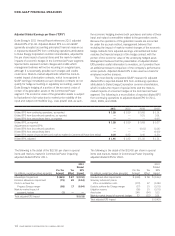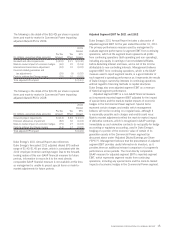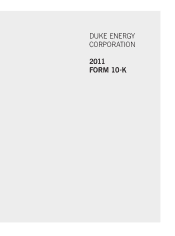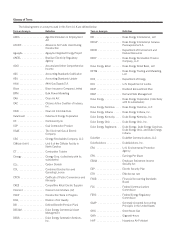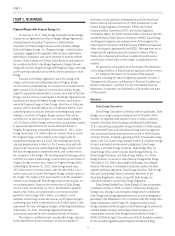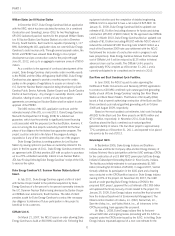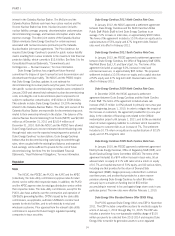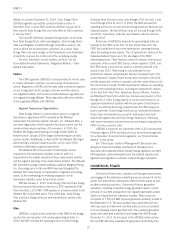Duke Energy 2011 Annual Report Download - page 26
Download and view the complete annual report
Please find page 26 of the 2011 Duke Energy annual report below. You can navigate through the pages in the report by either clicking on the pages listed below, or by using the keyword search tool below to find specific information within the annual report.
PART I
General.
Duke Energy is a Delaware corporation. Its principal executive
offices are located at 550 South Tryon Street, Charlotte, North
Carolina 28202-1803. Duke Energy Carolinas is a North Carolina
limited liability company. Its principal executive offices are located at
526 South Church Street, Charlotte, North Carolina 28202-1803.
Duke Energy Ohio is an Ohio corporation. Its principal executive
offices are located at 139 East Fourth Street, Cincinnati, Ohio
45202. Duke Energy Indiana is an Indiana corporation. Its principal
executive offices are located at 1000 East Main Street, Plainfield,
Indiana 46168.
The telephone number for the Duke Energy Registrants is
704-382-3853. The Duke Energy Registrants electronically file
reports with the Securities and Exchange Commission (SEC),
including annual reports on Form 10-K, quarterly reports on
Form 10-Q, current reports on Form 8-K, proxies and amendments
to such reports.
The public may read and copy any materials that the Duke
Energy Registrants file with the SEC at the SEC’s Public Reference
Room at 100 F Street, N.E., Washington, D.C. 20549. The public
may obtain information on the operation of the Public Reference
Room by calling the SEC at 1-800-SEC-0330. The SEC also
maintains an internet site that contains reports, proxy and information
statements, and other information regarding issuers that file
electronically with the SEC at http://www.sec.gov. Additionally,
information about the Duke Energy Registrants, including its reports
filed with the SEC, is available through Duke Energy’s Web site at
http://www.duke-energy.com. Such reports are accessible at no
charge through Duke Energy’s Web site and are made available as
soon as reasonably practicable after such material is filed with or
furnished to the SEC.
The following sections describe the business and operations of
each of Duke Energy’s reportable business segments, as well as
Other. (For more information on the operating outlook of Duke Energy
and its reportable segments, see “Management’s Discussion and
Analysis of Financial Condition and Results of Operations,
Introduction — Executive Overview and Economic Factors for Duke
Energy’s Business”. For financial information on Duke Energy’s
reportable business segments, see Note 3 to the Consolidated
Financial Statements, “Business Segments.”)
Duke Energy Business Segments.
Duke Energy conducts its operations in the following business
segments, all of which are considered reportable segments under the
applicable accounting rules: U.S. Franchised Electric and Gas
(USFE&G), Commercial Power and International Energy. The
remainder of Duke Energy’s operations are presented as Other. Duke
Energy’s chief operating decision maker regularly reviews financial
information about each of these business segments in deciding how
to allocate resources and evaluate performance. For additional
information on each of these business segments, including financial
and geographic information about each reportable business segment,
see Note 3 to the Consolidated Financial Statements, “Business
Segments.”
U.S. FRANCHISED ELECTRIC AND GAS
Service Area and Customers
USFE&G generates, transmits, distributes and sells electricity in
central and western North Carolina, western South Carolina, central,
north central and southern Indiana, and northern Kentucky. USFE&G
also transmits, distributes and sells electricity in southwestern Ohio.
Additionally, USFE&G transports and sells natural gas in
southwestern Ohio and northern Kentucky. It conducts operations
primarily through Duke Energy Carolinas, the regulated transmission
and distribution operations of Duke Energy Ohio, including Duke
Energy Kentucky, and Duke Energy Indiana (Duke Energy Ohio,
Duke Energy Indiana and Duke Energy Kentucky collectively referred
to as Duke Energy Midwest). These electric and gas operations are
subject to the rules and regulations of the FERC, the NCUC, the
PSCSC, the Public Utilities Commission of Ohio (PUCO), the Indiana
Utility Regulatory Commission (IURC) and the KPSC. The substantial
majority of USFE&G’s operations are regulated and, accordingly,
these operations qualify for regulatory accounting treatment.
Its service area covers 50,000 square miles with an estimated
population of 12 million. USFE&G supplies electric service to
four million residential, general service and industrial customers.
USFE&G provides regulated transmission and distribution services for
natural gas to 500,000 customers in southwestern Ohio and
northern Kentucky. Electricity is also sold wholesale to incorporated
municipalities, electric cooperative utilities and other load serving
entities.
Duke Energy Carolinas’ service area has a diversified general
service and industrial presence. Manufacturing continues to be an
important contributor to the region’s economy, along with financial,
professional and business services. Other sectors such as trade,
health care, local government and education also constitute key
components of the states’ gross domestic product. Chemicals,
computers and electronics, rubber and plastics, textile, paper and
motor vehicle manufacturing industries were among the most
significant contributors to the Duke Energy Carolinas’ industrial sales
revenue for 2011.
Duke Energy Ohio’s service area has a diversified general service
and industrial customer base. Major components of the
manufacturing sector include: aerospace and motor vehicles, metals,
chemicals and food. Other sectors include: real estate and rental
leasing, financial and insurance services, healthcare and wholesale
trade services. These are among the primary contributors to Duke
Energy Ohio’s industrial and general service sales revenue for 2011.
For Duke Energy Indiana, a significant portion of the service
territory’s economic output is driven by manufacturing. Chemicals,
transportation equipment, machinery and metal industries were the
primary contributors. Other sectors include: retail trade, government,
financial, health care and education services. Duke Energy Indiana’s
2011 industrial and general service sales were concentrated in the
aforementioned sectors.
The number of residential, general service and industrial
customers within the USFE&G service territory, as well as sales to
these customers, is expected to increase over time. However, growth
in the near-term is being hampered by the current economic
6


